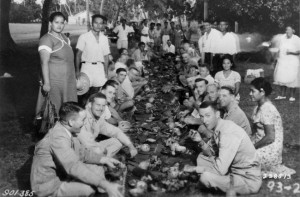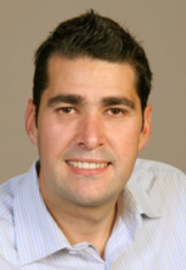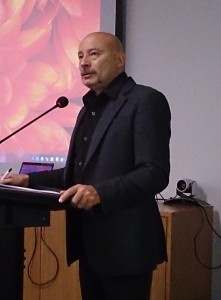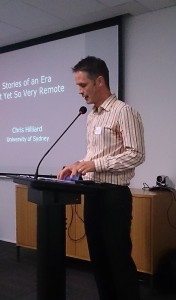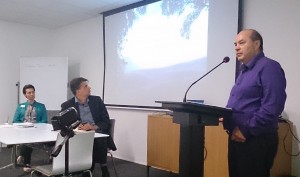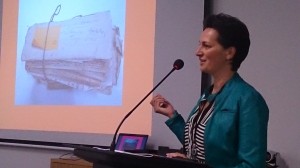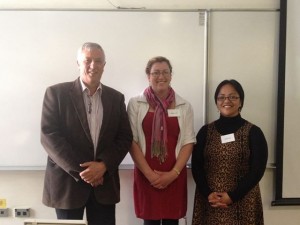Marsden Collection Online Soon
Two hundred years ago (in December) Rev Samuel Marsden gave the first Christian service on New Zealand soil at Oihi Bay, in the Bay of Islands, and planted the first group of missionaries before he sailed back to New South Wales. This early missionary activity generated considerable paper records between the missionaries, marsden, and the Church Missionary Society. These comprise the Marsden Papers at the Hocken Library, containing journals as well as hundred of letters. For over 20 years, Gordon Parsonson, a former member of Otago’s History Department – now aged 94, has been transcribing this hand-written material, some of which will soon go online.
Click here to see a recent Otago Daily Times article on Gordon Parsonson.
The digitization project has been led by the University Library and Hocken Library, with considerable input from the Centre for Research on Colonial Culture.
The Marsden project will go live in November, and will become a great resource for historians and other Humanities scholars.
Quick News: Overseas Invitations
Two of CROCC’s members are currently in Australia, having been invited to give presentations at universities there. CROCC Director is at the University of Brisbane, and gave a talk last night on “Colonial Knowledge Making” to the Centre for the History of European Discourses.
Angela Wanhalla will be presenting today on the Mothers Darlings Project, at the University of Melbourne, as part of the “Writing the Pacific: Re-writing Australia” symposium.
Born of Conflict video now available on Youtube
The video documentary, Born of Conflict: Children of the Pacific War is a major outcome of a Marsden-funded project, the Mothers’ Darlings Project, led by Judy Bennett and Angela Wanhalla (History) that investigates the lives of children born of US servicemen and indigenous women of New Zealand and the Pacific during World War Two. The documentary, a shorter version of which played on Maori TV this year as part of their ANZAC Day programming, looks at three case studies from the research. It also features Judy and Angela, both members of the Centre for Research on Colonial Culture, along with Louise Mataia (graduate of Otago and researcher on the Mothers’ Darlings Project).
The video was produced by Steven Talley, Peggy Holter and Judy Bennett, with funding support from University of Otago. Click here for free viewing.
Click here for more information on the work of the Mothers’ Darlings Project.
“A World History of Bluff”
Last year CROCC member, Dr Michael Stevens won a Fast Start Marsden Award to research how the Southland port of Bluff connected with the rest of the world, and how this impacted on the town (and vice-versa), in particular the local Kāi Tahu people. As the Royal Society stated, “As a “Bluffie” of Kai Tahu descent, Dr Stevens is ideally placed to carry out a research project that is meaningful to both academics and the local inhabitants.” In order to share his on-going research, Michael has created a new website “A World History of Bluff” with an associated Facebook Page.
New Biography on Richard Seddon
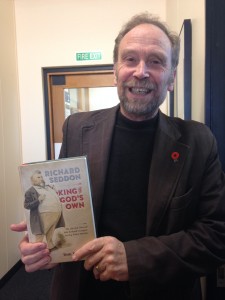 Richard Seddon was a colossal figure in New Zealand politics up to his death in 1906. His Liberal Party was New Zealand’s first modern political party; his government introduced old age pensions and votes for women, as well as an industrial conciliation and arbitration system. Seddon was able, for much of his time as Prime Minister, to gain the support from a wide range of the political spectrum, at the same time that the rest of the world marvelled at the country’s “socialist” experiments.
Richard Seddon was a colossal figure in New Zealand politics up to his death in 1906. His Liberal Party was New Zealand’s first modern political party; his government introduced old age pensions and votes for women, as well as an industrial conciliation and arbitration system. Seddon was able, for much of his time as Prime Minister, to gain the support from a wide range of the political spectrum, at the same time that the rest of the world marvelled at the country’s “socialist” experiments.
It has been almost 60 years since an authoritative biography of Seddon has appeared, R.M. Burdon’s King Dick. Until now! CROCC member, Professor Tom Brooking’s latest book Richard Seddon: King of God’s Own has just been published by Penguin Books, and gives us fresh insights into “the Life and Times of New Zealand’s Longest-serving Prime Minister”. Congratulations, Tom.
CRoCC member shortlisted for prestigious book prize
Congratulations to Angela Wanhalla, member of CRoCC and the University of Otago’s History Department, for the shortlisting of her recent book, Matters of the Heart: A History of Interracial Marriage in New Zealand, for the Ernest Scott Prize for History for 2014. This prize, given annually to the book judged to be the most distinguished contribution to the history of Australia or New Zealand or to the history of colonization, will be awarded at the upcoming Australian Historical Association Conference in Brisbane in July. Angela’s book was published by Auckland University Press.
Centre in He Kitenga
He Kitenga is the University of Otago’s annual publication highlighting leading research at the university. This year’s theme is Horizons. Click here to read more about the Centre for Research on Colonial Culture.
Cowan Symposium. Cultural Go-Between, Colonial Man: New Perspectives on James Cowan.
A successful one-day symposium was held at the National Library on Friday 21 February, a joint event run by Annabel Cooper of the Centre for Research on Colonial Culture and Ariana Tikao of the Alexander Turnbull Library. It attracted more than 65 attendees, including academics, librarians, archivists, professional and governmental historians, and other interested people. Chief librarian of the Alexander Turnbull Library, Chris Szekely, welcomed people to the event, and suggested that it was a good start to CROCC’s relationship with the Turnbull and National Library, and hopefully the first of many events. Chris’s welcome was followed by a mihi from the Turnbull’s Curator Māori, Paul Diamond.
Chris Hilliard (University of Sydney) returned to Cowan, a subject of research earlier in his career, with the keynote address ‘Stories of an Era Not Yet So Very Remote’ in which he asked us to look beyond Cowan’s grand statements – ones with which he can so easily be tied to the colonial project – to his love of detail, and it was through these that we could get a better understanding of the man. Chris stressed Cowan’s love of New Zealand history, and his connection with place and people.
The themes that Chris set out were picked up by the three speakers who followed. Paul Meredith of Ngāti Maniapoto, like Cowan, grew up in the Kihikihi area, and values the writer’s work, in particular his oral history, as a means of unlocking the voices of his tūpuna. He pointed out too that Cowan collaborated with Raureti Te Huia and the methods they used have parallels with the kaupapa Māori methodology of today.
Te Kenehi Teira of Ngāti Raukawa, Kaihautu Māori for the Historic Places Trust, spoke about the Trust’s development of interpretation and other resources for the Ōrākau commemorations, and a smartphone driving app for the Waikato battle sites. As Te Kenehi said, the app was a means of bringing Cowan into the modern world. The researchers utilised Cowan’s writings as a means of adding detail to the interpretations, and in the case of Ōrākau, of pinpointing the actual site of the pā.
This session was closed by Ariana Tikao of Kāi Tahu, Research Librarian Māori, who discussed the Turnbulls’ recent acquisition and description of 202 folders of Cowan manuscript material (acquired at the end of 2012) that now complements the Library’s existing collection. Ariana also talked about putting together Borderland: The World of James Cowan, (running to 26 April in the Alexander Turnbull Gallery), her exhibition exploring the writer’s life, work and legacy.
After lunch, we heard from Greg Woods who talked on Cowan’s years as a journalist at the Auckland Star (1888-1903). During this time Cowan wrote at least 370 feature articles, some of which he incorporated into his later books. Cowan was a “Māori specialist” perhaps due to his language skills, and unlike most reporters of the time, was able to add his name to these articles. While also shipping reporter Cowan met some famous writers, such as Rudyard Kipling, Mark Twain and Robert Louis Stevenson, and Greg argued that Cowan took Stevenson as a sort of literary model for his writing. Kathryn Parsons, Special Collections Librarian at the University of Waikato, discussed Cowan’s later writing for children in The Enzed Junior, a weekly Saturday supplement that ran from 1934 to 1941. Cowan wrote 255 articles for this publication, 190 of which were on Māori-related topics. Staying with young people, the final speaker in this session, Jim Frood, a history teacher at Kings College, Auckland spoke on the secondary schools history curriculum and the value of Cowan’s work as a resource in the teaching of Year 11-13 history.
Roger Blackley of VUW began the last session with a discussion on Pictures of Old New Zealand, comprising Lindauer portraits of Māori men and women with bibliographical information supplied by Cowan. Roger showed how Cowan re-used text written by earlier writers, such as James Mackay, but moderating some of the sentiments for the sensibilities of his own day. Although Cowan’s writing is about the people, rather than the art itself, Roger argued that Pictures of Old New Zealand might be considered New Zealand’s first art monograph. Lydia Wevers (Stout Centre, VUW) then spoke about Cowan’s travel writing, in particular his work on the Main Trunk Line written for railway tourism purposes. This work shows Cowan’s contradictory attitudes to colonialism, on the one hand accepting the inevitable march of progress, while also lamenting the loss of the bush, and the old Māori ways of life. Annabel Cooper (University of Otago) and Diane Pivac from New Zealand Film Archive, looked at Cowan’s influence on New Zealand films of the New Zealand Wars, from Rudall Hayward (for whom he worked as an advisor) to Geoff Murphy’s Utu, which was inspired by one of Cowan’s stories, to Vincent Ward’s River Queen. We were treated to excerpts from Hayward’s Te Kooti Trail, a silent movie in which Hayward used descendants of the historical figures as actors, and his last movie, Rewi’s Last Stand. Tony Ballantyne (University of Otago and CROCC Director) wrapped up the day, reminding us that Cowan is a more complex personality than superficial reading of his work might suggest.
NZHA Conference Makes History
The recent New Zealand Historical Association Conference, which held at the University of Otago from 20-22 November 2013, was special for a number of reasons. For the first time a panel session was offered in te reo Maori. Organised by CRoCC member Lachy Paterson, the te reo panel was both pioneering and well-received. Congratulations to Lachy and his co-panellists, Megan Potiki (Te Tumu) and Migoto Eria (Hawke’s Bay Museum and Art Gallery) on this fine achievement.
The NZHA conference also saw the premiere of a documentary, Children of War, a major outcome from Professor Judy Bennett’s Marsden-funded project on the fate of the children fathered by American servicemen with Indigenous women during the Pacific War. This was a particularly special event because Arthur Beren, who features in the documentary, was in attendance and spoke at the premiere as did Steven Talley, the producer of the documentary. Click on the highlighted text to read an Otago Daily Times story on the film.
Congratulations to the NZHA on a fine event and for making history by including a te reo panel and a film screening at the biennial conference for the very first time!
Mary Boyd Prize
Congratulations to Tony Ballantyne of CRoCC in winning the inaugural Mary Boyd Prize for the best published history essay. The judges were Margaret Tennant (Massey) and Felicity Barnes (Auckland) and was awarded at the NZHA conference dinner at Otākou Marae on Thursday 21 November for his essay “On Space, Place and Mobililty in Nineteenth-Century New Zealand” in the New Zealand Journal of History April 2011.

